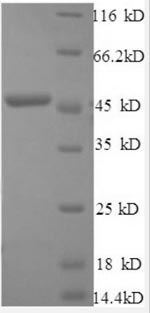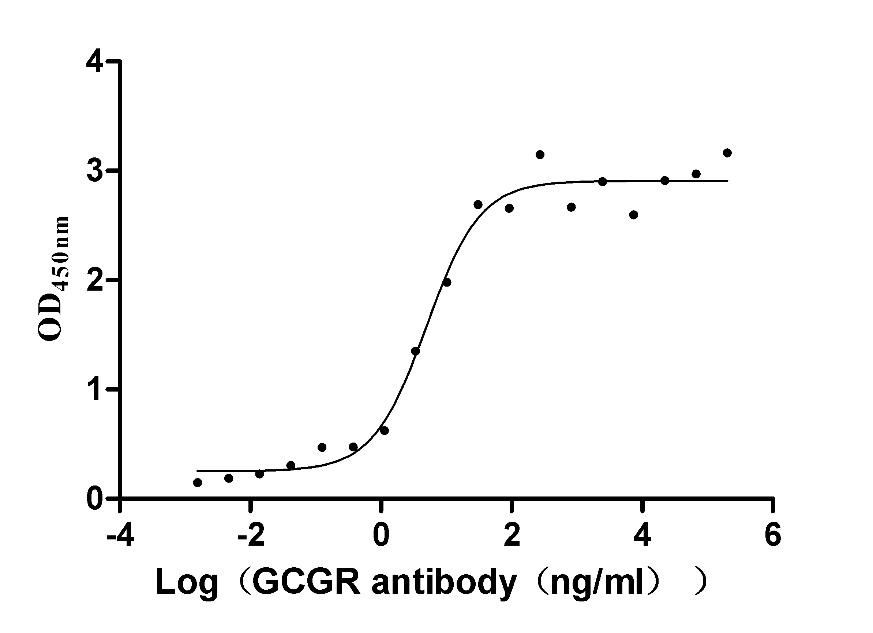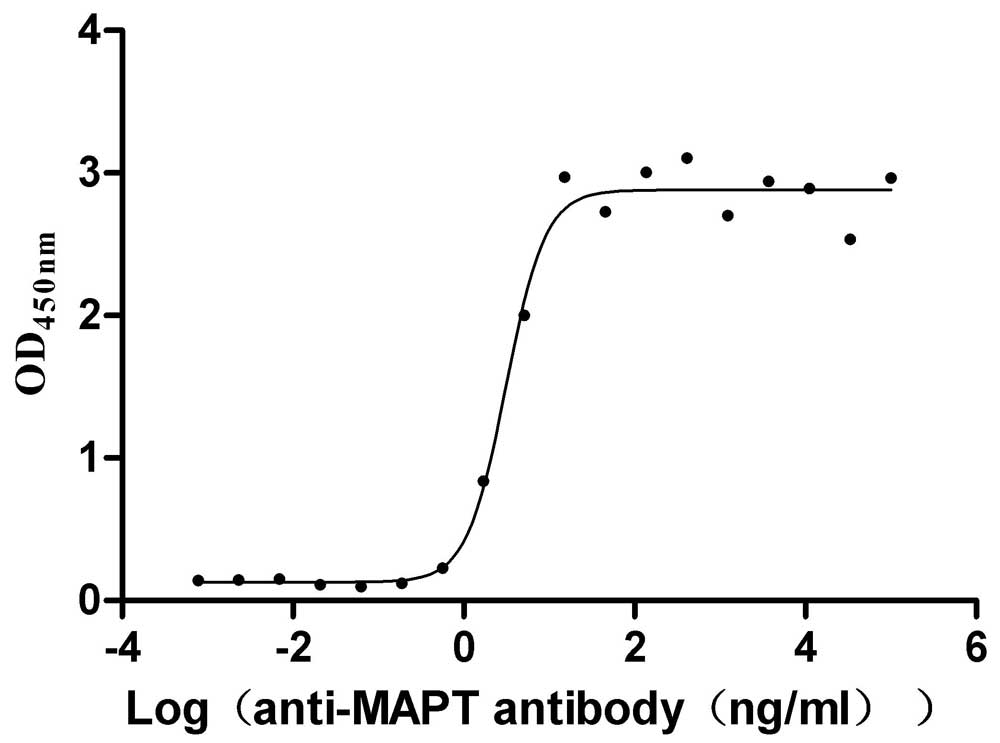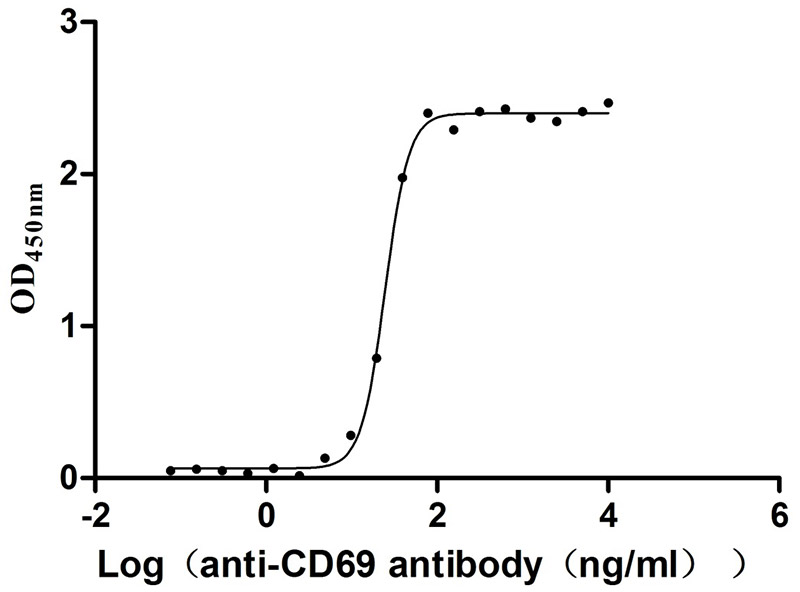Recombinant Human Interferon beta protein (IFNB1)
In Stock-
货号:CSB-EP011048HU
-
规格:¥1344
-
图片:
-
其他:
产品详情
-
纯度:Greater than 90% as determined by SDS-PAGE.
-
基因名:
-
Uniprot No.:
-
别名:beta-interferon; Fibroblast interferon; IFB ; IFF; IFN beta; IFN-beta; IFNB 1; IFNB; IFNB_HUMAN; IFNB1; Interferon beta 1 fibroblast ; Interferon beta; Interferon beta precursor ; MGC96956
-
种属:Homo sapiens (Human)
-
蛋白长度:Full Length of Mature Protein
-
来源:E.coli
-
分子量:47.0kDa
-
表达区域:22-187aa
-
氨基酸序列MSYNLLGFLQRSSNFQCQKLLWQLNGRLEYCLKDRMNFDIPEEIKQLQQFQKEDAALTIYEMLQNIFAIFRQDSSSTGWNETIVENLLANVYHQINHLKTVLEEKLEKEDFTRGKLMSSLHLKRYYGRILHYLKAKEYSHCAWTIVRVEILRNFYFINRLTGYLRN
Note: The complete sequence including tag sequence, target protein sequence and linker sequence could be provided upon request. -
蛋白标签:N-terminal GST-tagged
-
产品提供形式:Liquid or Lyophilized powder
Note: We will preferentially ship the format that we have in stock, however, if you have any special requirement for the format, please remark your requirement when placing the order, we will prepare according to your demand. -
缓冲液:Tris-based buffer,50% glycerol
-
储存条件:Store at -20°C/-80°C upon receipt, aliquoting is necessary for mutiple use. Avoid repeated freeze-thaw cycles.
-
保质期:The shelf life is related to many factors, storage state, buffer ingredients, storage temperature and the stability of the protein itself.
Generally, the shelf life of liquid form is 6 months at -20°C/-80°C. The shelf life of lyophilized form is 12 months at -20°C/-80°C. -
货期:3-7 business days
-
注意事项:Repeated freezing and thawing is not recommended. Store working aliquots at 4°C for up to one week.
-
Datasheet & COA:Please contact us to get it.
相关产品
靶点详情
-
功能:Has antiviral, antibacterial and anticancer activities.
-
基因功能参考文献:
- Data indicate a mechanism used by monocyte chemotactic protein-inducing protein 1 (MCPIP1) to negatively regulated type I IFN interferon-beta antiviral defense. PMID: 29920243
- It has been shown that HCMV has evolved mutational robustness against IFN-beta by limiting the presence of APOBEC3G hot spots in essential open reading frames of its genome. PMID: 30045985
- RIG-I-like receptors have a role in induction of interferon-beta1 in antiviral gene expression PMID: 29098213
- Transcriptomic analysis of early untreated dermatomyositis muscles revealed that the main cluster of down-regulated genes was mitochondria-related. Histochemical, electron microscopy, and in situ oxygraphy analysis showed mitochondrial abnormalities, including increased reactive oxygen species (ROS) production and decreased respiration, which was correlated with low exercise capacities and a type I IFN signature. PMID: 28623559
- Gas6 bound to the fiber proteins of adenovirus and suppressed IFN beta production. PMID: 29288958
- The overexpression of NPIPB3 restored the interferon-beta responses in severe acute respiratory syndrome coronavirus open reading frame 6 (SARS-CoV ORF6) expressing cells, indicating that the interaction of SARS CoV ORF6 and NPIPB3 reduced Type I interferon antagonism by SARS-CoV ORF6. PMID: 26320399
- The results demonstrate that cystatin B interferes with the STAT-1 signaling and IFN-beta-antiviral responses perpetuating HIV in macrophage reservoirs. PMID: 27137788
- This review briefly discusses the dysregulation of main T cell subpopulations in CNS autoimmunity and summarized the T cell targeted effects of endogenous and exogenous IFN-beta in health and EAE/MS, with emphasis on the direct actions of IFN-beta on each T cell subset involved in the disease. PMID: 27033173
- c-Cbl negatively regulates IFN-beta signaling and cellular antiviral response by promoting IRF3 ubiquitination and degradation. PMID: 27503123
- YPEL5 silencing enhanced the induction of IFNB1 by pattern recognition receptors and phosphorylation of TBK1/IKBKE kinases, whereas co-immunoprecipitation experiments revealed that YPEL5 interacted physically with IKBKE. PMID: 27705791
- The effect of topical TREX1 knockdown and local interferon production on HIV transmission in human cervicovaginal explants and humanized mice, is reported. PMID: 27184854
- The current knowledge on IFNbeta from its structure, dynamic conformation, signaling pathway, and mechanism of action to its therapeutic effects is summarized. PMID: 27572132
- this study shows that the IFN-beta/STAT1 pathway is dysregulated in inflammatory bowel disease PMID: 27220814
- results suggest that, in addition to its well-known signaling activity, IFN-beta may be directly antimicrobial and be part of a growing family of cytokines and chemokines, called kinocidins, that also have antimicrobial properties. PMID: 28411186
- This study demonstrates a novel pathway for elevated IFNbeta signaling in SLE that is not dependent on stimulation by immune complexes but rather is cell intrinsic and critically mediated by IFNbeta and MAVS. PMID: 28471483
- G45R mutation of NS1 slightly decreased NS1 binding to dsRNA but did not interfere with its suppression of RIG-I-mediated type I IFN production. PMID: 27405392
- Upon influenza virus infection, DPF2 dysregulated IFN-beta induction and expression of cytokines/chemokines and antiviral proteins. This study provides evidence that influenza virus utilizes DPF2 to escape host innate immunity. PMID: 28404846
- Overexpression of PKV VP3 blocked IFN-beta-induced activation of the STAT1/STAT2/IRF9 promoter in a dose-dependent manner. PMID: 28441586
- Data suggest that EV71 infection in enterocytes does not inhibit phosphorylation of STAT1/2 induced by IFN-beta, but p-STAT1/2 transport into the nucleus is significantly blocked; EV71 infection in enterocytes down-regulates expression of KPNA1 and induces degradation of cellular KPNA1 via caspase-3. [EV17 = Enterovirus 71] PMID: 28455446
- This study reveals that decreased induction of both PKR and p300 proteins contribute to impaired induction of IFN-beta in Chronic obstructive pulmonary disease primary bronchial epithelial cells upon influenza infection. PMID: 26807508
- Together, these results suggest that RSV infection of MSCs alters their immune regulatory function by upregulating IFN-b and IDO, affecting immune cell proliferation, which may account for the lack of protective RSV immunity and for chronicity of RSV-associated lung diseases such as asthma and COPD. PMID: 27695127
- ArfGAP domain-containing protein 2 (ADAP2) is identified as a key novel scaffolding protein that integrates different modules of the RIG-I pathway, located at distinct subcellular locations, and mediates cellular antiviral type I interferon production. PMID: 27956705
- TBK1 complexes required for the phosphorylation of IRF3 and the production of interferon-beta have been identified. PMID: 28159912
- RNAs isolated from HCV-replicating cells triggered robust IFN-beta and IFN-lambda production through MDA5. PMID: 27655134
- These results suggest that inhibition of RIG-I-mediated type I interferon responses by Enterovirus 71 may contribute to the pathogenesis of viral infection. PMID: 27633794
- the interactions of IRF1, IFN-beta and IRF5 are involved in the M1 polarization of macrophages and have antitumor functions. PMID: 27176664
- The results demonstrate that PASylation has a positive impact on stability, solubility, and functional activity of IFN-beta1b and potentially might improve pharmacokinetic properties of the molecule as a therapeutic agent. PMID: 27833991
- Data suggest that interferon beta (IFN-beta) might be involved in modulating the expressions of interferon regulatory factor 1 (IRF1) and interferon regulatory factor-5 protein (IRF5) as well as maintaining the M1 polarization status and its function. PMID: 27363262
- Results suggest that serum levels of IFN-beta do not correlate well with the severity of dengue illness, but there is a clear association between changes in IFN-beta levels and the days of evolution during the acute phase of the disease. PMID: 26252251
- Overexpression of KLF4 inhibited virus-induced activation of ISRE and IFN-b promoter in cells, while knockdown of KLF4 potentiated viral infection-triggered induction of IFNB1 and downstream genes and attenuated viral replication. PMID: 25531393
- These findings suggest that RNF166 positively regulates RNA virus-triggered IFN-beta production by enhancing the ubiquitination of TRAF3 and TRAF6. PMID: 26456228
- the suppression of type I IFN production by HTLV-1 Tax through interaction with and inhibition of TBK1 kinase that phosphorylates IRF3 PMID: 26819312
- IFN-b could be an effective agent not only through its cell growth inhibitory effect on GSCs but also as a means of targeting the interconversion between GSCs and non-GSCs. PMID: 26397698
- These results demonstrate that poliovirus infection actively suppresses the host type I interferon response by blocking activation of IRF-3 and suggests that this is not mediated by cleavage of MDA-5 or IPS-1. PMID: 26437794
- The Hantaan virus A9 N protein can influence the host innate immune response by regulating the activation of IFNbeta. PMID: 26196448
- Together, the data demonstrate that interferon-beta inhibits foamy virus early in infection and that MxB is not a restriction factor of foamy virus. PMID: 26609934
- The C-terminal region of Toscana Virus NSs protein is critical for interferon-beta antagonism and protein stability. PMID: 26474372
- These findings support a model in which a measles virus defective interfering RNA is sensed by PACT and RIG-I to initiate an innate antiviral response via activation of interferon-beta production. PMID: 26608320
- Data suggest microRNA-302c regulates interferon-beta production in innate/mucosal immunity partly via down-regulation of interferon regulatory factors IRF3/7; studies were conducted in lung epithelial cells infected with influenza A virus H3N2. PMID: 26602079
- Data show that the MAPKKK6 ASK2, a modulator of MAPKKK5 ASK1 signaling, was essential for ASK1-dependent apoptosis, but not for inducing interferon-beta (IFNB) expression. PMID: 26243192
- Data suggest ADAP2 (an interferon-beta stimulated gene) disrupts pathogenic internalization of some RNA viruses/virions (dengue, vesicular stomatitis) by altering ADP ribosylation factor 6-mediated processes including up-regulation of pinocytosis. PMID: 26372645
- Data suggest that naturally occurring iDVGs (immunostimulatory defective viral genomes) trigger robust host antiviral/innate immunity responses including/requiring up-regulation of IFNB1 and IFNL1 (interferon lambda 1) in respiratory mucosa. PMID: 26336095
- Data identify an IFNbeta1-dependent, cell-autonomous mechanism that contributes to the therapeutic resistance of melanoma via the PKCepsilon-ATF2 regulatory axis. PMID: 25728676
- Early IFN-beta induction regulated virus replication in glioblastoma cells, whereas delayed IFN-beta induction resulted in efficient virus replication in neuroblastoma cells. PMID: 25920530
- Virion-associated R6 the type I IFN response by preventing efficient binding of IRF3/CBP complexes to the IFN-beta promoter in the context of infection. PMID: 25972548
- new IFN-beta response genes were identified in B cells, with possible implications to B cell-specific functions PMID: 25025430
- Reduced myelin basic protein-induced CD4+ T-cell autoreactivity in interferon-beta-treated multiple sclerosis patients may be mediated by monocyte-derived interleukin-10 PMID: 25738751
- Influenza virus-infected cells respond with increased induction of interferon beta upon Staphylococcus aureus super-infection, however, subsequent interferon-stimulated gene expression are rather impaired due to a block of STAT1-STAT2 dimerization. PMID: 25293394
- Paracrine signaling increases the number of cells that express Ifnb1 over time, calibrating the immune response to viral infection. PMID: 25670204
- Data suggest that BRD4 (bromodomain containing 4) is essential for Toll-like receptor-stimulated interferon-beta (IFNB) gene transcription by permitting transcription factors to interact with the IFNB promoter in plasmacytoid dendritic cells. PMID: 25891802
显示更多
收起更多
-
亚细胞定位:Secreted.
-
蛋白家族:Alpha/beta interferon family
-
数据库链接:
HGNC: 5434
OMIM: 147640
KEGG: hsa:3456
STRING: 9606.ENSP00000369581
UniGene: Hs.93177
Most popular with customers
-
Recombinant Human Glucagon receptor (GCGR), partial (Active)
Express system: Mammalian cell
Species: Homo sapiens (Human)
-
Recombinant Macaca mulatta Microtubule-associated protein tau (MAPT) (Active)
Express system: Mammalian cell
Species: Macaca mulatta (Rhesus macaque)
-
Recombinant Human Cannabinoid receptor 1 (CNR1)-VLPs (Active)
Express system: Mammalian cell
Species: Homo sapiens (Human)
-
Recombinant Human Zymogen granule protein 16 homolog B (ZG16B) (Active)
Express system: Mammalian cell
Species: Homo sapiens (Human)
-
Recombinant Human Desmoglein-2 (DSG2), partial (Active)
Express system: Mammalian cell
Species: Homo sapiens (Human)
-
Recombinant Human Early activation antigen CD69 (CD69), partial (Active)
Express system: Mammalian cell
Species: Homo sapiens (Human)
-
Recombinant Human Oncostatin-M (OSM), partial (Active)
Express system: Mammalian cell
Species: Homo sapiens (Human)
-
Recombinant Rat Gastric inhibitory polypeptide receptor (Gipr), partial (Active)
Express system: Mammalian cell
Species: Rattus norvegicus (Rat)





















